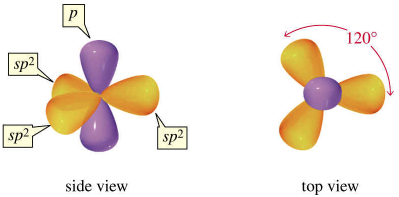Recently, there has been a lot of discussion of Bent's rule (see for example "What is Bent's rule?") here in SE Chem. Simply stated, the rule suggests that $\mathrm{p}$-character tends to concentrate in orbitals directed at electronegative elements.
Why does $\ce{F}$ replace an axial bond in $\ce{PCl5}$?
In order to answer this question, we need to start by understanding the bonding in $\ce{PCl5}$ and its fluorinated isomers. In introductory courses and texts, it is usually stated that $\ce{AX5}$ type molecules adopt a trigonal bipyramid geometry and are $\mathrm{sp^{3}d}$ hybridized. As the comments by Martin and permeakra point out, and as is learned in more advanced classes, this hybridization scheme is likely incorrect. There are several reasons that argue against $\mathrm{sp^{3}d}$ hybridization including: 1) the fact that $\mathrm{d}$ orbitals are relatively high in energy compared to $\mathrm{s}$ and $\mathrm{p}$ orbitals and therefore it is energetically quite costly to involve them in bonding; and 2) $\mathrm{d}$ orbitals in non-metals are very diffuse leading to poor overlap with other orbitals and any resulting bonds would be very weak.
A reasonable hybridization alternative involves what is termed hypercoordinated bonding; where 3 center, 4 electron bonds are involved. Applying this concept to $\ce{PCl5}$ we would say that the central phosphorus atom is $\mathrm{sp^2}$ hybridized. Thus, there would be 3 $\mathrm{sp^2}$ orbitals (these will be used to create the equatorial bonds) and a $\mathrm{p}$ orbital (this will be used to create our axial bonds) emanating from the central phosphorus atom.

The $\mathrm{p}$ orbital contains 2 electrons and will form bonds to 2 ligands (chlorine or fluorine in the case at hand). For simplicity, let's say that these ligands also use $\mathrm{p}$ orbitals for bonding (but it could be any type of orbital, $\mathrm{sp^3}$ or whatever is appropriate) and each of these orbitals contains one electron for bonding. This is our 3-center-4-electron bond and its MO diagram is pictured below. Notice how the four electrons are distributed - there are two electrons in the HOMO which is a non-bonding M.O., so the bond order in this bond is reduced.

This reduced bond order in the bond using the phosphorus $\mathrm{p}$ orbital explains why the axial bonds in $\ce{AX5}$ type molecules are longer than the equatorial bonds.

Now that we understand the bonding in $\ce{PCl5}$ we can consider the case of $\ce{PCl4F}$ and how Bent's rule applies to the situation. First, note that fluorine is more electronegative than chlorine. As stated above, Bent's rule suggests that more electronegative ligands prefer to form bonds with orbitals that are high in $\mathrm{p}$-character. Why is this? $\mathrm{s}$-Orbitals are lower in energy than $\mathrm{p}$-orbitals. Therefore electrons are more stable (lower energy) when they are in orbitals with more $\mathrm{s}$-character. The two electrons in the $\ce{P-F}$ bond will spend more time around the electronegative fluorine and less time around phosphorus. If that's the case (and it is), why "waste" precious, low-energy, $\mathrm{s}$-orbital character in an orbital that doesn't have much electron density to stabilize. Instead, save that $\mathrm{p}$-character for use in phosphorus hybrid orbitals that do have more electron density around phosphorus (like the $\ce{P-Cl}$ bonds). So, as a consequence of Bent's rule, we would expect phosphorus to use the orbital with lowest $\mathrm{s}$-character, the axial $\mathrm{p}$-orbital, to form the $\ce{P-F}$ bond; and the orbitals with more $\mathrm{s}$-character, the equatorial $\mathrm{sp^2}$ orbitals, to form $\ce{P-Cl}$ bonds.



